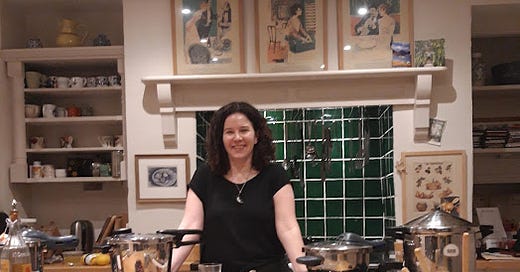Last week I talked about Natural Pressure Release (NPR) which is the easy one as you simply just take your cooker off the heat and let it do its own thing. It is always preferable to use NPR where possible, not least because it is a gentler process and because as it gives the steam time to convert back into liquid, you don’t end up with a kitchen full of steam.
However, sometimes no matter how short a time you are cooking at pressure, you will need to use Fast Pressure Release (FPR). This is to prevent certain foods from overcooking. Remember that food does keep cooking as the cooker drops pressure and some delicate foods – I am thinking of certain vegetables in particular – are cooked in the time it takes for the cooker to come up to pressure, so it is impossible to factor in NPR. Sometimes the difference between al dente and mush can be as little as 30 seconds! So to state the obvious a bit, to avoid overcooking you have to depressurize the cooker fast, which means you have to get rid of the steam, fast. This generally means a steamy kitchen, but as you will see below, there are ways around this.
So FPR does require active participation on your part if you are using a stovetop, and regardless of type, you need to understand how to do this safely. In simple terms, all you need to do is remove your cooker from the heat source and use your pressure cooker’s steam release mechanism to expel the steam until the pressure gauge drops and the lid seal is loosened. There is no getting away from the fact that FPR will mean steam coming out of your pressure cooker, in either a continuous flow or in short bursts. You just need to make sure you are doing it in as controlled a way as possible.
This is not as scary or dangerous as some would have you believe - even though when first faced with it, it can make people jump. I know this from the many demos I have done! (The photo above is me at a demo, anticipating the coming up to pressure and FPR of 4 pressure cookers pretty much simultaneously - a bit of theatre which was great fun without filling the kitchen with too much steam).
Historically, the thought of what might happen when releasing pressure was one of the things which made people nervous. I think I may have mentioned the person whose mother used to send her into the garden every time she wanted to fast release pressure, because she was terrified that the jiggling weight was going to fly off when she touched it. No one wants a piece of hot metal flying through their kitchen.
However, as usual, this was a feature of the old style pressure cookers – very few new models come with removable, jiggling weights. Not only that, although the steam does have to come out - I can’t stress this enough – there are ways to mitigate the fierceness of the steam release. And if you are using a stove top there are ways to avoid it completely, without over cooking your food.
Let’s deal with the mechanisms first, which will differ depending on your brand/model. There are 3 main types. The most common is a dial which you switch from high pressure to low pressure to no pressure. Others have a slide mechanism on the handle which also serves to lock the lid in place. Some have a combination of both of these. Finally there is the sort which involves directly depressing or pulling the pressure gauge.
These mechanisms give you varying degree of control. The most control comes with the sliding mechanism on the handle as you can let out the steam in a continuous flow, but control the speed. So, using my WMF as an example, I can pull the slide to open the vent very slightly and just leave it while it expels the steam safely at a steady rate. If I think it is coming out too fast, I can push it back towards being closed again, if I think it can safely let it out at a faster rate, I can pull it out a little more.
The dial and pressure gauge mechanisms are slightly harder to control – this is because you can’t leave these to release at a slow and steady rate but either in one fast continuous stream or in short bursts. With the dial mechanism, I tend to move it back and forth between high and low, then low and no, just to start with and to get rid of most of the steam. When it slows down, I will twist all the way round and then leave it to get rid of anything remaining. With the pressure gauge mechanism, you can either press it down completely so all the steam comes out at once, or again, you can do it in short bursts which will give you more control.
Why do you need the control? Well, if the steam comes out too fast it might bring with it spitting water droplets. But also, if you are cooking anything starchy (eg, pasta or rice*) and your pressure cooker is fairly full, you also run the risk of a very starchy liquid coming out of your vents, which can potentially block them. You really want to avoid this if possible, not least because you will have to be much more rigorous with your cleaning afterwards.
If you have an electric pressure cooker, you will have the same options of fast or natural release. The fast release can be automated, but in some cases you will need to switch the pressure release valve from “seal” to “vent”. This mechanism is very similar to the sort of dial you find on some stove tops. You can control it in the same way too, moving it from open to shut to keep the steam coming out in short more controllable bursts. Some models will also give you the option for “intermittent pressure release” which basically automates this short burst process rather than letting the steam out in one continuous flow. I would always recommend you use this if cooking anything starchy, or if your pressure cooker is particularly full.
While you are getting used to FPR, I recommend standing back as you release the pressure because you won’t be familiar with the direction the steam will come out. If I am letting the steam out particularly fiercely (sometimes I am in that much of a hurry), I might wear an oven glove. And when I am depressing the pressure gauge in my Kuhn Rikon which is in the centre of the lid, I sometimes use a wooden spoon as the gauge can get hot.
Finally, if you are using a stove top, there is a way to depressurise without filling your kitchen with steam. Simply put the base of your pressure cooker in a bowl or sink of cold water OR put it under a running cold tap. You will find that the pressure gauge will drop in seconds. It makes a very satisfying “flump” sound as it does so and you will feel the lid release its tight grip on the pan. When you remove the lid you will find that there will be no more steam than if you had been cooking in a conventional saucepan. I hope I don’t need to say this, but feel I should just in case: YOU MUST NOT DO THIS WITH AN ELECTRIC PRESSURE COOKER!
*Why cook things like pasta using the FPR method? Because how long the cooker takes to drop pressure depends a bit on brand and size and it is easy to forget about a pressure cooker when it is off the heat, dropping pressure - catastrophic for pasta and noodles in particular which can really over cook. I have started to work out methods for starchy foods, combining natural and fast release to get more precision on timings as well as cutting down on the time spent at pressure. You might notice I already do this for some recipes in Modern Pressure Cooking – eg., the quick soak method for beans, and I will be expanding this a lot over the next few months.






Another helpful column Catherine. Thank you!
It seems possible to replace NPR with a longer FPR sometimes. Any thoughts on that? Thanks.